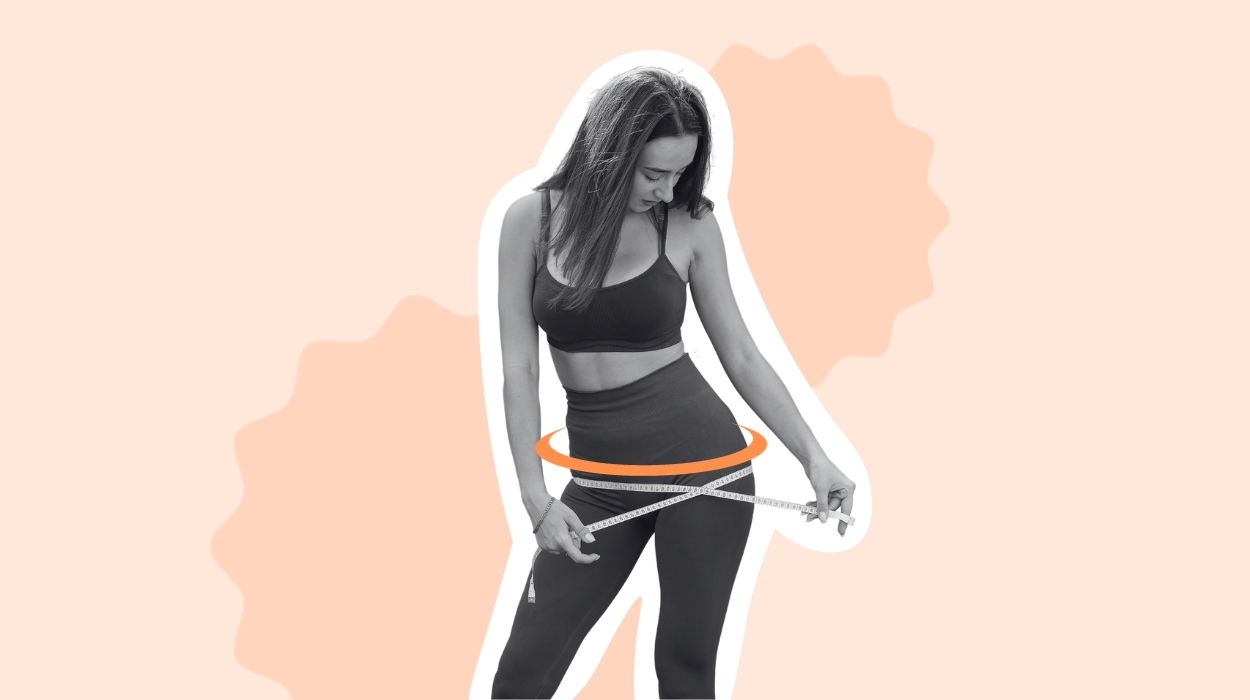Embarking on a journey to trim hip fat can often seem like navigating through a maze of advice. One clear path, though, is understanding the balance of carbs per day to fuel your body while still encouraging it to dip into those reserves around your hips. While no magic formula exists for targeting hip fat specifically, a combination of science-backed strategies can pave the way for significant changes.
It’s not only about aesthetic goals but also about embracing a healthier lifestyle where you feel empowered and invigorated. So, if you’re contemplating how to lose hip fat, let’s explore some evidence-based methods that promise to kickstart your metabolism and reshape your physique.
How To Get Rid Of Hip Fat?
- Squats and Lunges: Build strength in the glutes and quads while enhancing balance and posture.
- Hip Thrusts: Isolate and engage the gluteus maximus for improved tone and strength.
- HIIT Workouts: Increase metabolism and burn fat with high-intensity interval training.
- Pilates and Barre: Target smaller muscle groups for precision toning and improved core strength.
- Side Planks and Leg Lifts: Strengthen the core and hip muscles while improving stability and posture.
How To Lose Hip Fat – Best Exercises To Try
Engaging in targeted exercises is a potent strategy to redefine the contours of your hips. It can help you understand how to get rid of hip fat and help you lose weight. The key is consistency and the right blend of movements.
Squats And Lunges – The Classic Duo
These exercises are time-tested and effectively engage the largest muscle groups in your body, the quadriceps and glutes,[1] which are integral to hip shaping.
Squats and lunges are foundational movements that target your lower body muscles, building strength in your glutes, quads, and hamstrings. They can be modified to suit fitness levels from novice to expert and can be performed with just your body weight or with added resistance.
These exercises do more than just work your muscles. They enhance joint mobility[2] and improve balance and posture. This not only aids in performing the exercises correctly but also translates into everyday movements.
By activating some of the largest muscle groups in the body, these exercises increase your caloric expenditure contributing to fat loss and learning how to lose hip fat fast. Moreover, they stimulate muscle growth, which is essential for a toned appearance including leaner hips.
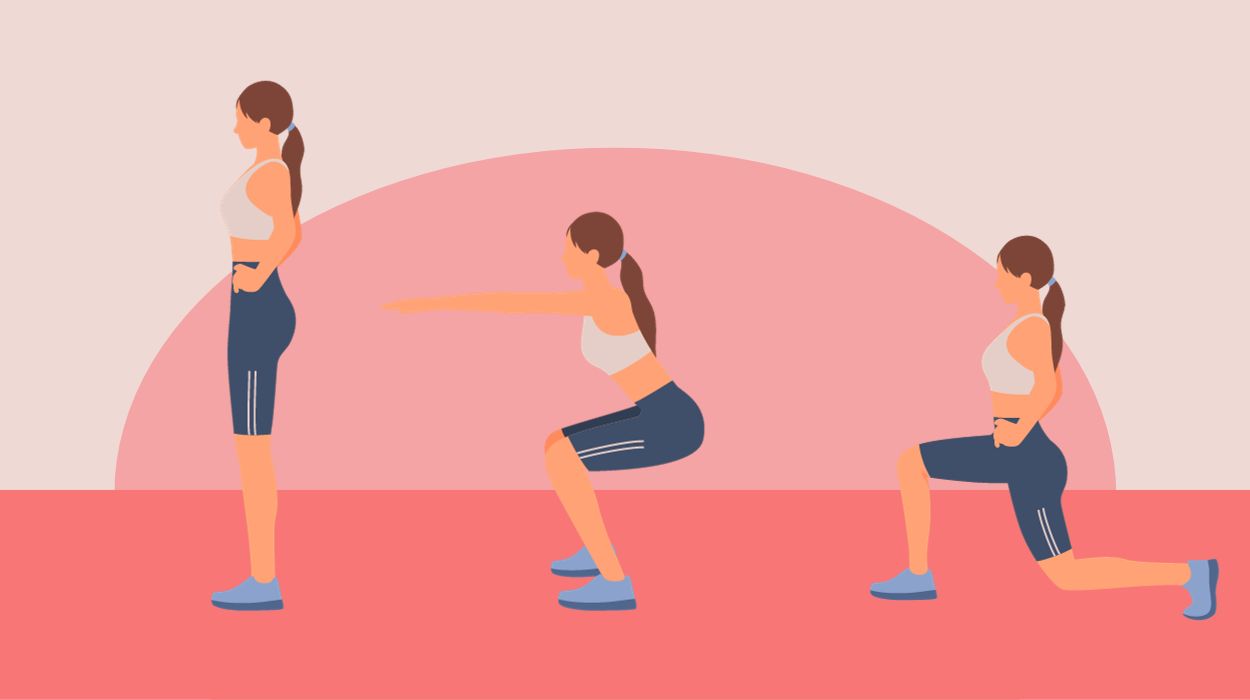
How to do:
- Start by standing with your feet shoulder-width apart.
- Perform a squat by bending your knees and pushing your hips back, as if sitting into a chair.
- As you return to the standing position from the squat, immediately step one foot backward into a lunge position.
- Lower your body into a lunge, making sure both knees form 90-degree angles.
- Push off the front foot to return to the standing position.
- Alternate between legs, stepping back into a lunge with the opposite leg.
Tips:
- When doing squats and lunges, ensure your knees don’t go beyond your toes, keep your back straight, and engage your core muscles for stability. This will help prevent injury and maximize the effectiveness of the exercises.
- Focus on a slow and controlled motion throughout the exercise, both during the descent and ascent. This helps engage the targeted muscles more effectively and reduces the risk of injury.
- Remember to inhale as you lower your body and exhale as you push back up to the starting position. Proper breathing helps maintain stability and provides better energy during the exercises.
Optimal Sets and Reps: Three to four sets of 10 to 15 reps for each exercise.
Hip Thrusts
Does hip thrust reduce hip fat? This powerful exercise specifically targets the gluteus Maximus,[3] the main muscle of the hips, enhancing strength and tone. Hip thrusts are celebrated for their ability to isolate and engage the gluteus maximus intensely. This exercise can lead to significant muscle strengthening and toning, which is vital for altering the shape and appearance of your hips.
As with any resistance exercise, hip thrusts can help raise your basal metabolic rate. This means you’ll burn more calories throughout the day,[4] even at rest, facilitating the loss of fat around the hip area.
While primarily targeting the glutes, hip thrusts also work the hamstrings and build lower back[5] strength. This comprehensive lower body workout supports hip health and contributes to a more powerful, athletic physique. Hip thrusts can be performed anywhere. Start by moving only your body weight, you can then introduce resistance with bands or weights.
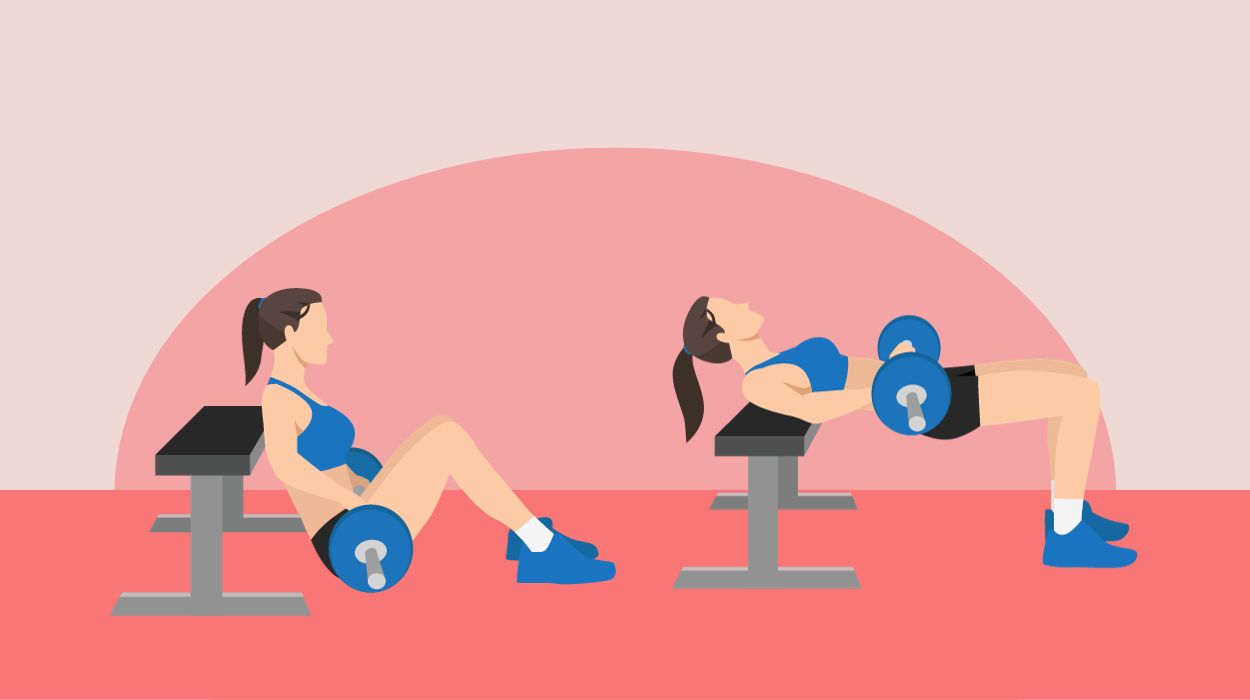
How to do:
- Begin by sitting on the floor with your upper back against a bench or stable surface.
- Place a padded barbell or weight plate over your hips or use a resistance band placed just above your knees for added resistance.
- Bend your knees at a 90-degree angle and plant your feet flat on the ground, hip-width apart.
- Roll the barbell or weight plate over your hips so it’s directly above your pelvic region.
- Engage your glutes and core muscles to lift your hips off the ground, creating a straight line from your shoulders to your knees at the top of the movement.
- Squeeze your glutes tightly at the peak of the motion.
- Lower your hips back down, just hovering above the ground, and then lift again, repeating the movement.
- Perform your desired number of reps while focusing on proper form and controlled movements.
Tips:
- Ensure your upper back is firmly against a bench or stable surface, and your feet are hip-width apart with knees at a 90-degree angle. This alignment helps protect your spine and maximizes glute engagement.
- At the top of the hip thrust, contract and squeeze your glutes as hard as you can for a second or two before lowering down. This will maximize muscle activation and strength gains.
- Start with a weight or resistance band that challenges you but allows for good form. As you get stronger, gradually increase the weight or resistance to continue progressing.
Optimal Sets and Reps: Three to four sets of eight to 12 reps per set for hip thrust exercise.
High-Intensity Interval Training
HIIT can be effective for fat loss around the hips by increasing post-exercise oxygen consumption,[6] often referred to as the afterburn effect. HIIT involves short bursts of intense exercise alternated with low-intensity recovery periods. It’s a time-efficient way to exercise and is particularly effective for those looking for how to lose hip fat fast.
HIIT can include a variety of exercises such as sprinting, jumping jacks, or burpees, which can be tailored to suit any fitness level. This adaptability prevents workout plateaus keeping your body guessing and helping to burn calories efficiently.
HIIT offers a multi-faceted approach to fitness, effectively boosting metabolism for increased calorie burn during and post-workout. This intensity is particularly beneficial in reducing subcutaneous fat. HIIT engages the entire body, regardless of gender, making it an excellent strategy for those seeking to lose hip fat.
This full-body involvement not only maximizes calorie expenditure[7] but also enhances muscle toning while the versatility allows it to be practiced in various settings, from parks to living rooms, making it an accessible form of exercise for many, even those without access to specialized exercise equipment.
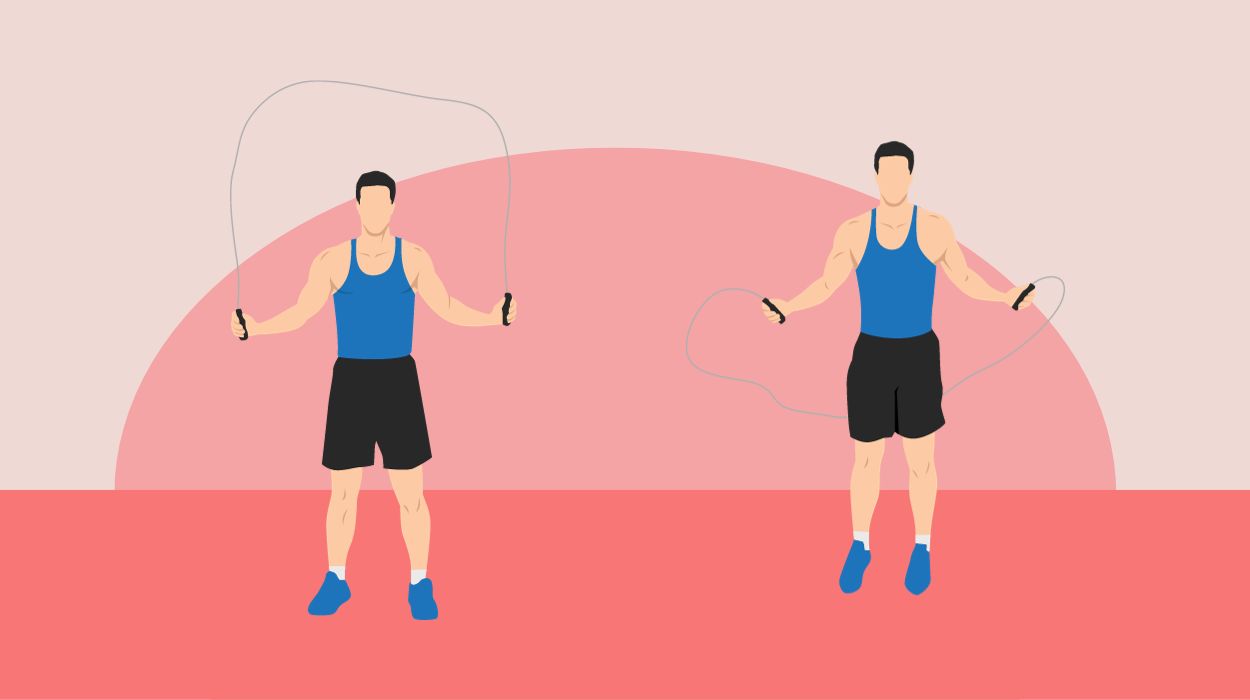
How to do:
- Begin with a five to 10-minute warm-up, incorporating light cardio exercises like jogging in place, jumping jacks, or brisk walking to raise your heart rate and prepare your muscles.
- Select a high-intensity exercise like sprinting, cycling, burpees, jumping rope, or mountain climbing.
- Perform the chosen exercise at maximum effort for 20-30 seconds, aiming to elevate your heart rate significantly and work your muscles intensely.
- Take a 10-20 second rest or perform a low-intensity exercise like walking or slow jogging to recover slightly.
- Repeat the work and rest phases for four to six rounds, depending on your fitness level and the length of your workout.
- Finish with a five to 10-minute cool-down, focusing on deep breathing and stretching exercises to gradually lower your heart rate and prevent muscle soreness.
- Rehydrate with water or an electrolyte drink, and allow your body to recover for at least 24 hours before your next HIIT session.
Tips:
- Always begin your HIIT session with a thorough warm-up to prevent injuries. Include dynamic stretches and light cardio exercises for five to 10 minutes to prepare your muscles and increase your heart rate gradually.
- Focus on maintaining proper form during the high-intensity intervals. Good form ensures maximum effectiveness and reduces the risk of injury.
- Pay attention to your body’s signals. If you’re a beginner or experiencing fatigue, it’s okay to start with shorter intervals and fewer sets. Gradually increase the intensity and duration as your fitness improves.
Optimal Sets and Reps: Four to six rounds of 20-30 seconds of high-intensity exercise followed by 10-20 seconds of rest or low-intensity recovery.
Pilates And Barre
These workouts emphasize precision and control, targeting the smaller muscle groups around the hip area to sculpt and tone.
Pilates and barre exercises are low-impact workouts, making them ideal for individuals wanting to lose hip fat without straining their joints. This combination of core and hip targeting with a gentle approach caters to a broad audience.
These forms of exercise not only enhance strength and flexibility but also contribute to functional fitness. Improved muscle function and flexibility are key for anyone aiming to lose hip fat. The benefits extend beyond aesthetics, enhancing daily movements and facilitating a physically active lifestyle.
Pilates and barre are more than physical workouts; they incorporate a mindfulness element that fosters a strong mind-body connection. This aspect is particularly beneficial in reducing stress levels. The decreased stress is associated with reduced fat storage,[8] aiding those on a mission to lose fat, especially from the hips.
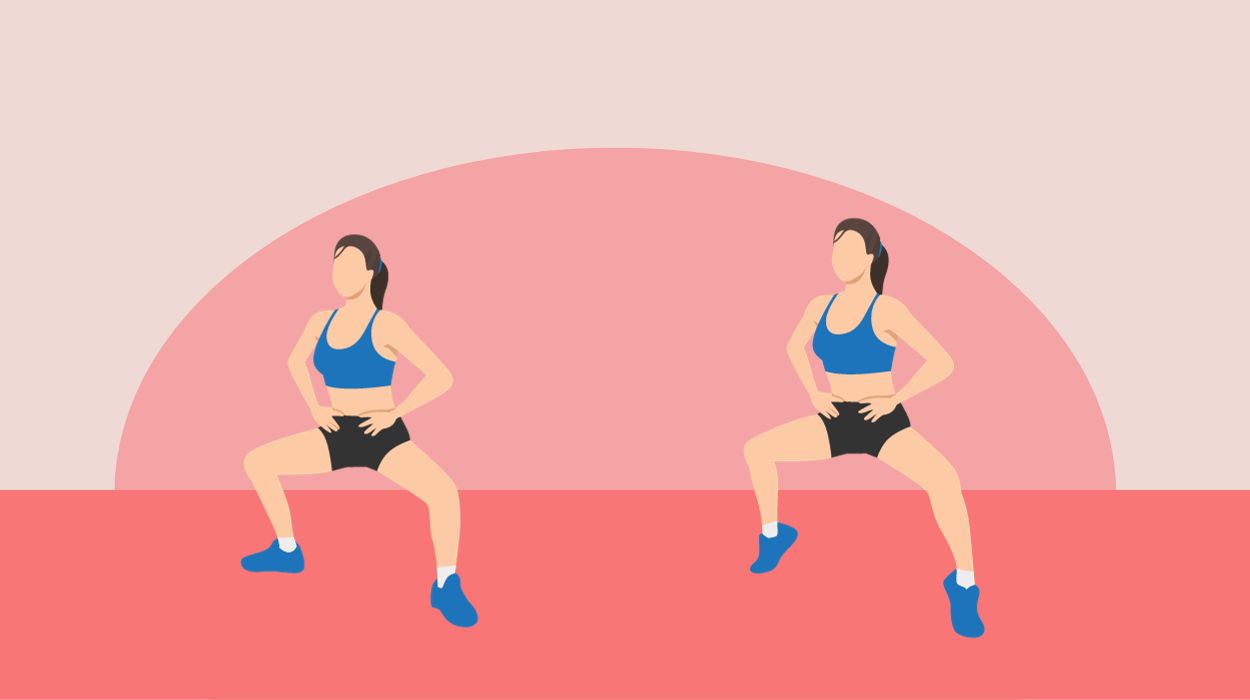
How to do:
- Begin with a five to ten-minute warm-up, incorporating light cardio exercises like marching in place or gentle leg swings to prepare your body for the workout.
- Start with Pilates mat exercises, such as the hundred, roll-up, and single-leg circles, to engage your core and improve flexibility.
- Move to a sturdy support like a ballet barre or the back of a sturdy chair to perform barre exercises.
- Begin with plie exercises, where you stand with your heels together, toes turned out, and perform controlled squats while engaging your core.
- Continue with barre toning exercises like leg lifts, side leg raises, and small pulsing movements to target the lower body muscles.
- Incorporate barre arm exercises using light weights or resistance bands to work on the upper body’s strength and tone.
- Return to the mat for Pilates stretching exercises like the cat-cow stretch, child’s pose, and spine stretch forward to enhance flexibility and relax your muscles.
- Finish with a five to 10-minute cool-down that includes gentle stretches for all major muscle groups and deep breathing exercises.
- Rehydrate with water and allow your body to recover, focusing on deep breathing and relaxation.
Tips:
- Maintain proper alignment throughout both Pilates and Barre exercises, paying special attention to your posture, core engagement, and positioning of your feet and limbs for maximum effectiveness and injury prevention.
- Emphasize controlled, precise movements in both Pilates and Barre. Slow and deliberate motions help engage the targeted muscles and improve muscle endurance.
- Practice mindful breathing, coordinating your breath with your movements. Inhale through the nose during the preparation phase and exhale through the mouth during the effort phase of each exercise to enhance relaxation and focus.
Optimal Sets and Reps: Three to four sets of eight to 12 reps per exercise.
Side Planks And Leg Lifts
Side planks and leg lifts serve as a powerful combination for engaging and strengthening your core and hips. Side planks activate the deep abdominal muscles, enhancing core stability and strength. Leg lifts specifically target the hip abductors and adductors, which are crucial for hip shaping. The coordinated effort of these exercises helps increase the metabolic rate, aiding in fat reduction.
Consistent training in these movements improves posture and functional stability, benefiting overall movement efficiency. This exercise combination ensures muscles work in unison, which is more effective for toning and focusing on how to lose hip fat.
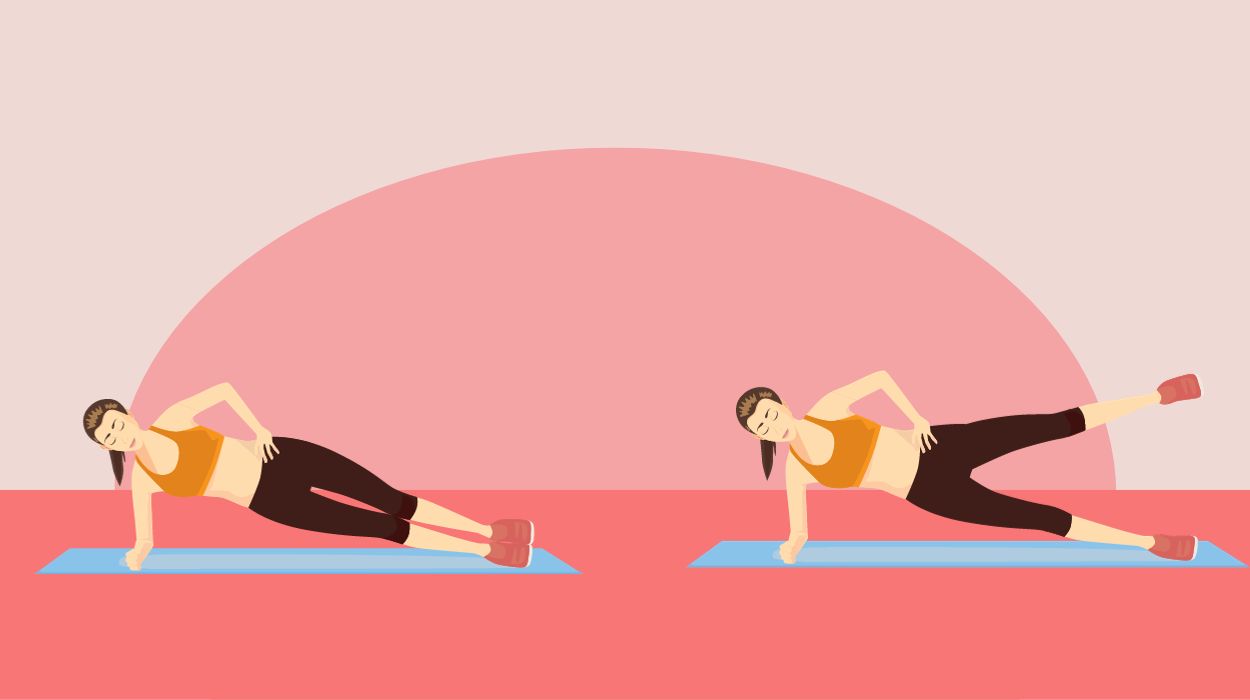
How to do:
- Begin by lying on your side with your legs stacked on top of each other and your elbow directly beneath your shoulder for support.
- Lift your body off the ground, creating a straight line from your head to your heels, engaging your core and glutes.
- While maintaining the side plank position, slowly lift your top leg as high as possible without compromising your balance or form.
- Hold the leg lift at the highest point for a moment, then lower it back down, maintaining the side plank position.
- Perform 10-15 leg lifts on one side before switching to the other side.
Tips:
- Ensure your body forms a straight line from head to heels during the side plank and leg lifts. Avoid any sagging or arching of the hips to protect your lower back and maximize core engagement.
- Perform leg lifts slowly and with control to avoid swinging or compromising your balance. Focus on the quality of the movement, not speed.
- Balance your workout by performing an equal number of sets and reps on both sides to avoid muscle imbalances.
Optimal Sets and Reps: Three to four sets of eight to 12 reps per exercise.
Why Stubborn Fat Accumulates On Your Hips?
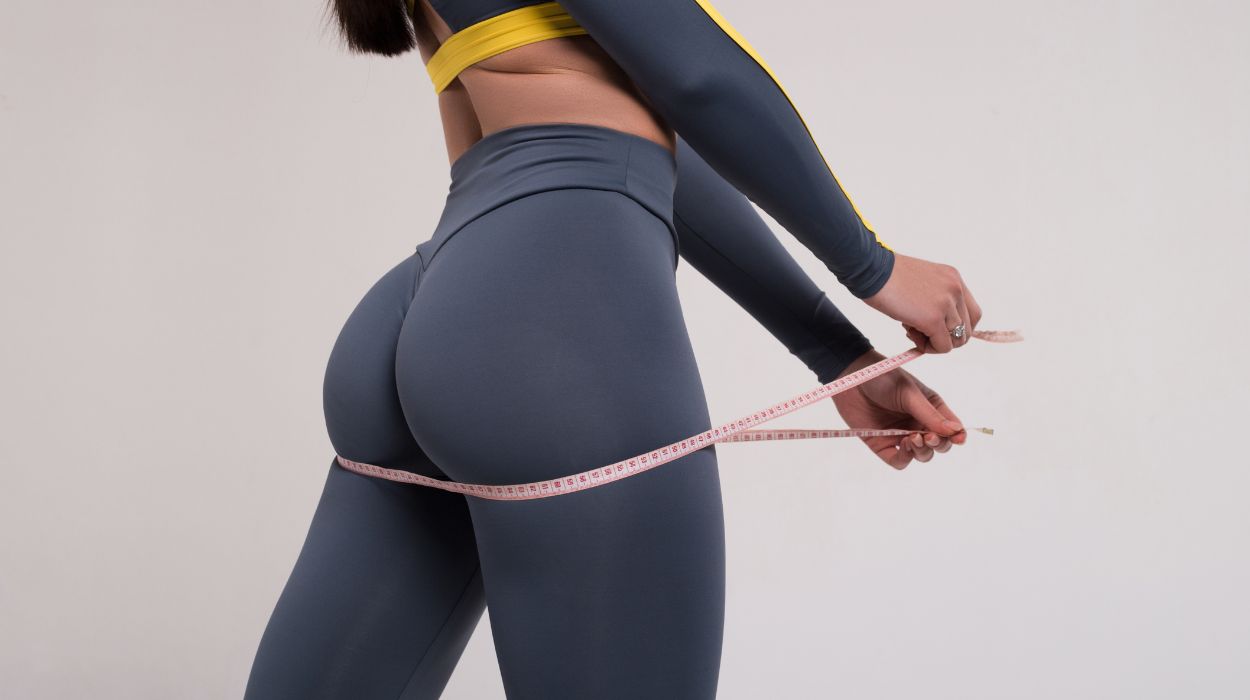
Understanding the why behind fat accumulation on your hips is as crucial as how to address it.
Hormonal Influence
The intricate dance of hormones within our bodies plays a pivotal role in how and where we store fat. Delving into the hormonal influences gives us insight into the stubborn nature of hip fat.
In women, the hormone estrogen directs fat to be stored in the hips, buttocks, and thighs.[9] While this pattern supports fertility and breastfeeding, it can also make it challenging to lose hip fat.
The stress hormone cortisol can lead to increased abdominal fat,[10] which sometimes extends to the hip area. Managing stress is thus a subtle but essential aspect of trying to lose hip fat fast.
Genetic Predisposition
Genetic predisposition[11] plays a non-negotiable role in determining body shape and fat distribution. It’s the underlying genetic blueprint that can make some individuals more prone to storing fat in their hips, thighs, and buttocks.
This is often observed as a family trait, where patterns of weight gain and body shape can be seen to be consistent across generations. If your relatives tend to carry more weight around their hips, you may likely have inherited this trait as well.
While genetics can set the stage for where your body stores fat, they don’t dictate your overall health destiny. Understanding your genetic propensity can be empowering, allowing you to tailor your fitness and dietary strategies more effectively. For those with a genetic inclination to accumulate hip fat, combining targeted exercises with a balanced, healthy diet can help in managing and redistributing overall body fat more evenly.
Lifestyle Factors
Daily habits and choices significantly impact body composition, often leading to the accumulation of fat around the hips.
Sedentary Behavior
A sedentary lifestyle can contribute to overall weight gain, which often includes increased hip fat. Incorporating more exercises and movement throughout the day is key to counteracting this and understanding how to get rid of hip fat.
Dietary Habits
Consuming greater calories than your body burns typically leads to fat accumulation. Utilizing a calorie deficit is pivotal in managing body fat levels.
Age-Related Changes
As time marches on, our bodies undergo a series of natural transformations that can affect weight distribution, particularly around the hips.
As you age, your metabolism naturally slows down. This leads to greater ease of gaining weight and a more difficult time losing it, especially around the hips. Age also causes muscle mass to decrease, leading to a slower metabolic rate. Engaging in regular strength training can help maintain muscle mass and manage hip fat.
Gender-Specific Tendencies
The battle to lose hip fat can also be swayed by gender-specific tendencies due to the differences in fat distribution between men and women.[12] Men are more likely to accumulate fat around the abdomen, leading to the familiar ‘apple shape,’ while women often gain weight around the hips and thighs, known as the ‘pear shape,’ especially noticeable when trying to lose thigh fat.
These patterns are not just cosmetic; they have implications for health and the strategies used to manage weight. For men wondering how to lose hip fat, the approach might focus more on overall weight loss and targeted core workouts, considering the tendency for abdominal fat. Women, on the other hand, seeking to lose hip fat, might need to employ strategies that address the estrogenic influence on fat distribution.
In both cases, an understanding of one’s body type and hormonal balance is essential. Tailored exercise routines, alongside dietary adjustments, can lead to more effective weight management and help in reducing hip fat.
By understanding these factors, you’re better equipped to address hip fat. A combination of tailored exercises informed dietary choices, and stress management can create a comprehensive approach to reducing hip fat and enhancing your health.
Other Ways To Reduce Fat Around Your Hips
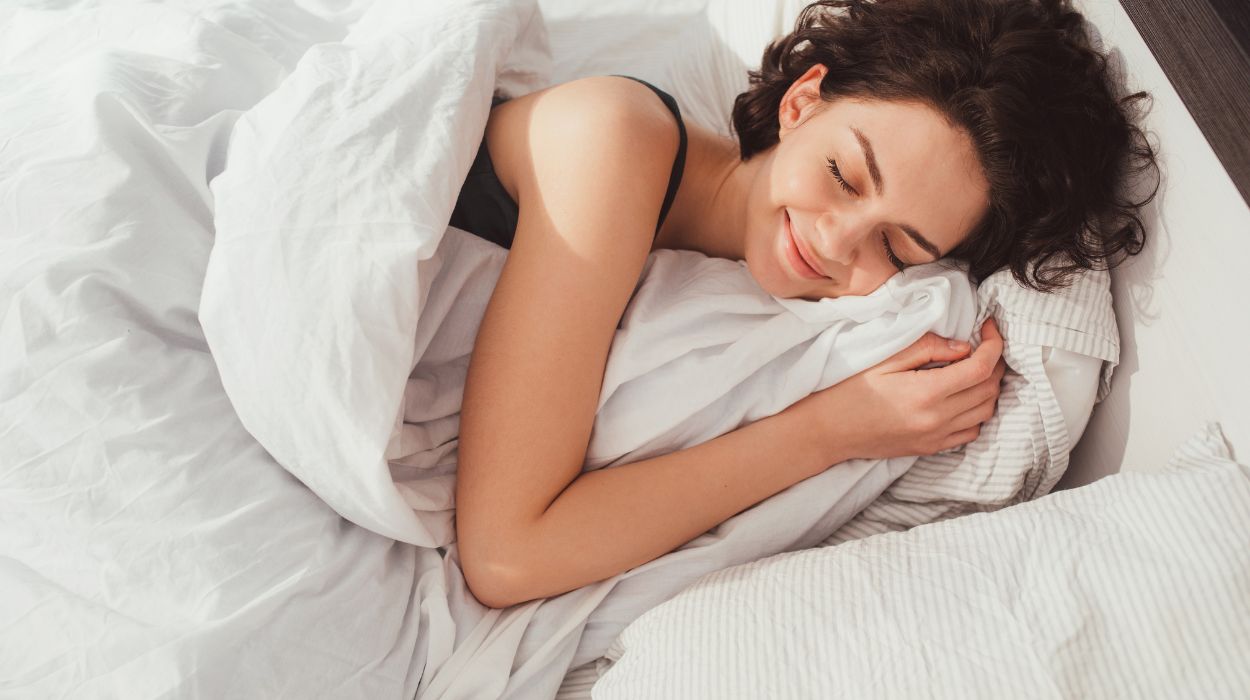
To augment your weight loss journey and goal of reducing fat around the hips, a blend of dietary management and lifestyle modifications can be instrumental:
- Monitor Calorie Intake: Understanding and managing your daily caloric intake is vital. For guidance on how to create a calorie deficit, which is essential for fat loss, consider consulting with a nutritionist or using online resources and focusing on healthy foods.
- Limit Sugars and Refined Carbs: To lose hip fat without exercising more effectively, it’s recommended to reduce the intake of added sugars and refined carbohydrates. These can contribute to fat accumulation around the hips.
- Quality Sleep: Prioritize getting 7-9 hours of good-quality sleep per night, as sleep deprivation[13] can affect hormones that regulate appetite and fat storage.
- Stress Management: High stress levels can lead to fat accumulation, especially around the midsection. Techniques such as meditation, yoga, or even regular exercise can help manage stress.
- Supplements: Consider incorporating a supplement that supports weight management, in consultation with a healthcare provider, to potentially aid in your fat loss goals.
- Mindful Eating: Being mindful of your eating habits can prevent overeating. Pay attention to your body’s hunger cues and eat slowly to increase satiety.
Remember, these are complementary strategies that should go hand-in-hand with a well-structured fitness plan for optimal results in your quest to lose hip fat.
Summary
Toning hip fat is a multidimensional approach involving specific exercises, a healthy diet, and understanding the underlying factors of fat storage. When you are trying to figure out how to get rid of hip fat and reduce belly fat, patience and persistence, paired with these strategies, can lead to the results you’re aiming for.
Frequently Asked Questions
Fat storage on the hips often results from a combination of genetics, hormone levels, and lifestyle choices, such as diet and activity levels.
A combination of strength training exercises targeting the hips and thighs, cardiovascular activity, and a nutritious diet can help slim these areas.
While walking can contribute to overall weight loss, which may include the hips, targeted exercises are typically needed for more significant hip size reduction.
Running can help create a calorie deficit, which may lead to fat loss around the hips; however, spot reduction is not possible with running alone.
 Evidence Based
Evidence Based